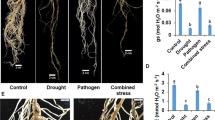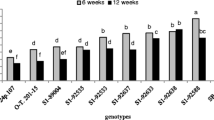Abstract
There have been many reports of the high incidence of sugar beet root rot fungi following the drought stress periods in Iran. This study was conducted to evaluate the yield and resistance of sugar beet commercial cultivars to the fungal root rots after drought stress. Thirty cultivars were planted in randomized complete block design in two different fields over two consecutive years (2018–2019). In order to apply drought stress, an irrigation system was designed based on the evaporation of 180 mm water from the class (A) pan and compared with the stress-free plots. The area under the disease progress curve (AUDPC) was calculated based on the rate of plant loss progress in three monitoring dates after drought stress. Also, the final white sugar yield (WSY ha−1) was calculated after harvest. The results of AUDPC and WSY ha−1 (Year × Field) were obtained for each cultivar. Plant losses in drought stress plots were 23.05% more than stress-free plots. The high resistance to root rot (100 < AUDPC < 600) was observed in 43.3% of total cultivars under drought stress. The 85% of resistant cultivars showed high or medium WSY ha−1 (WSY > 10). A significant relationship was observed between WSY ha−1 rates and resistant cultivars under drought stress and stress-free plots. The study confirmed the effect of drought stress on the predisposition of sugar beet commercial cultivars to fungal root rots. As a result, the most resistant and high-performance cultivars were identified under drought conditions for greater productivity.






Similar content being viewed by others
References
Abdollahian-Noghabi M (1999) Ecophysiology of sugar beet cultivars and weed species subjected to water deficiency stress. PHD. thesis, The university of Reading, Reding, Berkshire, England
Abyaneh HZ, Farrokhi E, Varkeshi MB, Ahmadi M (2012) Determination of water requirement and effect of its variations on some quantitative and qualitative traits of sugar beet product. J Sugar Beet 27 (2):21–27. https://doi.org/10.22092/jsb.2012.705
Agrios GN (2005) Plant pathology. 5th Edition, Elsevier Academic Press, Amsterdam, 26–27, 398–401
Asher MJ, Hanson LE (2006) Fungal and bacterial diseases. In: Draycott AP (Ed). Sugar Beet: Chapter 12, 286–315. https://doi.org/10.1002/9780470751114.ch12
Biancardi E, McGrath JM, Panella LW, Lewellen RT, Stevanato P (2010) Sugar Beet. In: Bradshaw JE, ed. Root and Tuber Crops. Handbook of Plant Breeding: Springer, NY, 173–219. https://doi.org/10.1007/978-0-387-92765-76
Biancardi E, Panella L, Lewellen RT (2012) Beta maritima: The origin of sugar beet. Dordrecht-Heidelberg-London: Springer New York.
Blaker N, MacDonald J (1981) Predisposing effects of soil moisture extremes on the susceptibility of rhododendron to Phytophthora root and crown rot. Phytopathology 71(83):1–834. https://doi.org/10.1094/Phyto-71-831
Bostock RM, Pye MF, Roubtsova TV (2014) Predisposition in plant disease: exploiting the nexus in abiotic and biotic stress perception and response. Annu Rev Phytopathol 52:517–549. https://doi.org/10.1146/annurev-phyto-081211-172902
Campbell CL, Madden LV (1990) Intoduction to plant disease epidemiology. John Wiley and Sons, New York
Cattivelli L, Rizza F, Badeck F-W, Mazzucotelli E, Mastrangelo AM, Francia E, Marè C, Tondelli A, Stanca AM (2008) Drought tolerance improvement in crop plants: An integrated view from breeding to genomics. Field Crop Res 105(1–2):1–14. https://doi.org/10.1016/j.fcr.2007.07.004
Chegini M, Rezaei-rad B, Ghalebi S (2010) Determination of crop transpiration coefficient (Kc) at various growth stages of sugarbeet. Plant Ecophysioloy 2:31–36
Comas L, Becker S, Cruz VMV, Byrne PF, Dierig DA (2013) Root traits contributing to plant productivity under drought. Front Plant Sci 4:442. https://doi.org/10.3389/fpls.2013.00442
Cooke DA, Scott RK (1993) The sugar beet crop. Springer Science & Business Media. https://doi.org/10.1007/978-94-009-0373-9
Dikilitas M, Karakas S, Hashem A, Abd Allah EF, Ahmad P (2016) Oxidative stress and plant responses to pathogens under drought conditions. In: Water Stress and Crop Plants. Wiley, 102–123. https://doi.org/10.1002/9781119054450.ch8
Doorenbos J, Pruitt W (2014) Crop water requirements, FAO Irrigation and Drainage Paper No. 24. FAO Rome, Italy
Duniway JM (1977) Changes in resistance to water transport in safflower during the development of phytophthora root rot. Phytopathology 77(3):331. https://doi.org/10.1094/Phyto-67-331
Ebrahimi KH, Mahmoudi S (2010) Evaluation of the resistance of sugar beet breeding lines to rhizoctonia root and crown rot. Journal of Sugar Beet 26(1):31–42
Faostat F (2012) Disponível em:> http://faostat.fao.org>. Acesso em 14
Fattahi S, Zafari D, Mahmoudi B (2011) Evaluation of superior sugar beet genotypes for resistance to important root rot pathogens in the greenhouse. Journal of Sugar Beet 27(1):25–38
Hecker R, Ruppel E (1977) Rhizoctonia root rot resistance in sugar beet: breeding and related research. Journal of American Society of Sugar Beet Technolology 19(3):246–256
Hill A, Reeves P, Larson R, Fenwick A, Hanson L, Panella L (2011) Genetic variability among isolates of Fusarium oxysporum from sugar beet. Plant Pathol 60(3):496–505. https://doi.org/10.1111/j.1365-3059.2010.02394.x
Jasniã SM, Stojšin VB, Bagi FF (2005) Sugarbeet root rot in drought conditions. Matica Srpska Proceedings for Natural Sciences 109:103–111
Kamilova F, Kravchenko LV, Shaposhnikov AI, Makarova N, Lugtenberg B (2006) Effects of the tomato pathogen Fusarium oxysporum f. sp. radicis-lycopersici and of the biocontrol bacterium Pseudomonas fluorescens WCS365 on the composition of organic acids and sugars in tomato root exudate. Mol Plant-Microbe Interact 19(10):1121–1126. https://doi.org/10.1094/MPMI-19-1121
Karadimos D, Tsialtas J, Maslaris N, Papakosta D (2006) Root rot disease of sugar beet (Beta volgaris L.) as affected by defoliation intensity. Proceedings for Natural Sciences Matica Srpska 110:123–127
Kari A (2001) Disease incidence of common root and foot-rot on Durum wheat in semi-arid conditions in Cyprus, 208. Technical Bulletin. Cyprus Agricultural Research Institute
Kerr S, Leaman M (1997) To water or not. British Sugar Beet Review 65(2):11–13
Leslie JF, Summerell BA (2008) The Fusarium laboratory manual. John Wiley & Sons. https://doi.org/10.1002/9780470278376
Mahalingam R (2015) Combined stresses in plants. Springer International Publishing, Switzerland. https://doi.org/10.1007/978-3-319-07899-1
Mahmoudi B, Mesbah M (2004) Pathogenic variability of sugar beet isolates of Rhizoctonia solani. Iranian J Plant Pathol 40(3–4):253–280
Mahmoudi SB, Ghashghaie S (2013) Reaction of sugar beet S1 lines and cultivars to different isolates of Macrophomina phaseolina and Rhizoctonia solani AG-2-2IIIB. Euphytica 190(3):439–445. https://doi.org/10.1007/s10681-012-0832-8
Neibling W, Gallian J (1997) Irrigation water management in sugarbeet production. University of Idaho Cooperative Extension System
Norouzi P, Stevanato P, Mahmoudi SB, Fasahat P, Biancardi E (2017) Molecular progress in sugar beet breeding for resistance to biotic stresses in sub-arid conditions-current status and perspectives. J Crop Sci Biotechnol 20(2):99–105. https://doi.org/10.1007/s12892-016-0090-0
Ober ES, Le Bloa M, Clark CJ, Royal A, Jaggard KW, Pidgeon JD (2005) Evaluation of physiological traits as indirect selection criteria for drought tolerance in sugar beet. Field Crop Res 91(2–3):231–249. https://doi.org/10.1016/j.fcr.2004.07.012
Ober ES, Rajabi A (2010) Abiotic stress in sugar beet. Sugar Tech 12(3–4):294–298. https://doi.org/10.1007/s12355-010-0035-3
Pandey P, Irulappan V, Bagavathiannan MV, Senthil-Kumar M (2017) Impact of combined abiotic and biotic stresses on plant growth and avenues for crop improvement by exploiting physio-morphological traits. Front Plant Sci 8:537. https://doi.org/10.3389/fpls.2017.00537
Peters K, Breitsameter L, Gerowitt B (2014) Impact of climate change on weeds in agriculture: a review. Agron Sustain Dev 34(4):707–721. https://doi.org/10.1007/s13593-014-0245-2
Pidgeon JD, Ober ES, Qi A, Chris JA, Clark CJA, Royal A, Jaggard KW (2006) Using multi-environment sugar beet variety trials to screen for drought tolerance. Field Crop Res 95(2–3):268–279. https://doi.org/10.1016/j.fcr.2005.04.010
Schimel J, Balser TC, Wallenstein M (2007) Microbial stress-response physiology and its implications for ecosystem function. Ecology 88(6):1386–1394. https://doi.org/10.1890/06-0219
Schneider C, Whitney E (1986) Root diseases caused by fungi. Compendium of beet diseases and insects Edited by ED Whitney and JE Duffus American Phytopathological Society, St Paul, Minn:17–23
Schneider DJ, Collmer A (2010) Studying plant-pathogen interactions in the genomics era: beyond molecular Koch’s postulates to systems biology. Annu Rev Phytopathol 48:457–479. https://doi.org/10.1146/annurev-phyto-073009-114411
Schoeneweiss DF (1975) Predisposition, stress, and plant disease. Annual Rev Phytopathol 13(1):193–211. https://doi.org/10.1146/annurev.py.13.090175.001205
Schoeneweiss DF (1978) Water stress as a predisposing factor in plant disease. Water Deficits and Plant Growth 5:61–90. https://doi.org/10.1016/B978-0-12-424155-8.50008-0
Sneh B, Burpee L, Ogoshi A (1991) Identification of Rhizoctonia species. APS Press St, Paul, Minnesota USA
Stamps DJ, Waterhouse G, Newhook F, Hall G (1990) Revised tabular key to the species of Phytophthora. vol Ed. 2. CAB-International
Stevanato P, Broccanello C, Pajola L, Biscarini F, Richards C, Panella L, Hassani M, Formentin E, Chiodi C, Concheri G (2017) Targeted next-generation sequencing identification of mutations in disease resistance gene analogs (RGAs) in wild and cultivated beets. Genes 8(10):264. https://doi.org/10.3390/genes8100264
Taleghani D, Gohari G, Tohidloo V, Roohi A (2008) Study, water and nitrogen use efficiency, optimum conditions and stress, in two sugar beet planting pattern. Final Rep Res Ins Sugar Beet
Wakelin S, Gomez-Gallego M, Jones E, Smaill S, Lear G, Lambie S (2018) Climate change induced drought impacts on plant diseases in New Zealand. Australasian Plant Pathol 47:101–114
Whitney E, Duffus JE (1986) Compendium of beet diseases and insects. American Phytopathological Society, USA
Zhan A, Schneider H, Lynch JP (2015) Reduced lateral root branching density improves drought tolerance in maize. Plant Physiol 168(4):1603–1615. https://doi.org/10.1104/pp.15.00187
Acknowledgements
The authors would like to thank the Research Deputy of the Sugar Beet Seed Intitue (SBSI) and Agricultural research and education center of west Azarbayjan, for plant material supply and implementation of field operations.
Author information
Authors and Affiliations
Corresponding author
Ethics declarations
Ethical approval
This article does not contain any studies with human participants or animals performed by any of the authors.
Informed consent
Informed consent was obtained from all participants included in the study. All participants have seen and approved the manuscript, and have taken a valid role through study design, data generation, or manuscript preparation.
Conflict of interest
The authors declare that they have no conflict of interest.
Rights and permissions
About this article
Cite this article
Moshari, S., Mahmoudi, S.B., Hemmati, R. et al. Evaluation of yield and resistance of sugar beet cultivars to fungal root rots under drought stress. Australasian Plant Pathol. 51, 91–100 (2022). https://doi.org/10.1007/s13313-021-00830-z
Received:
Accepted:
Published:
Issue Date:
DOI: https://doi.org/10.1007/s13313-021-00830-z




